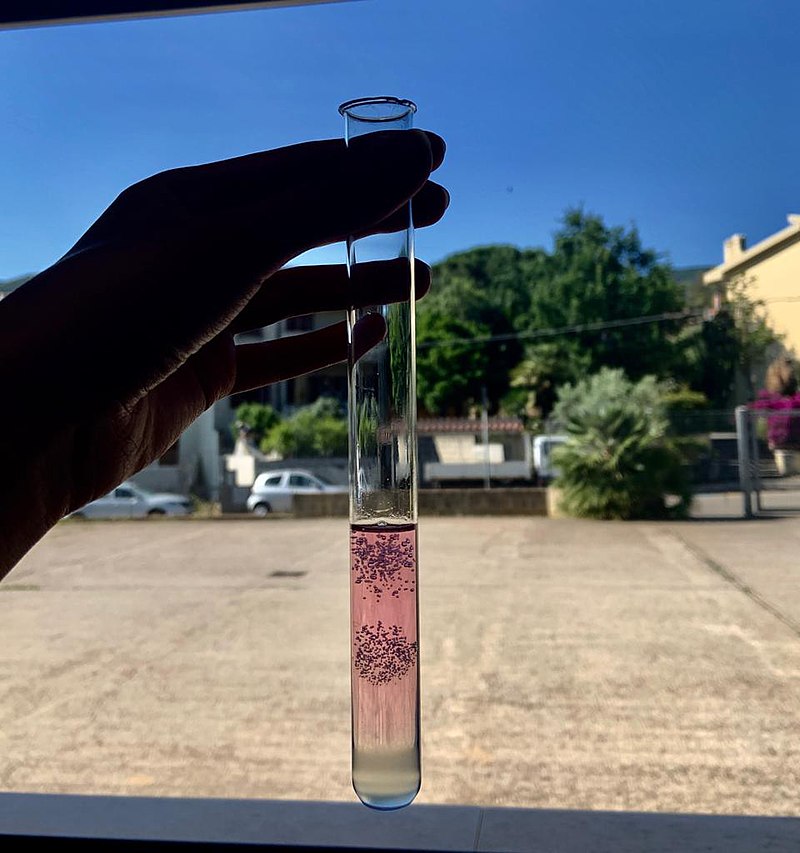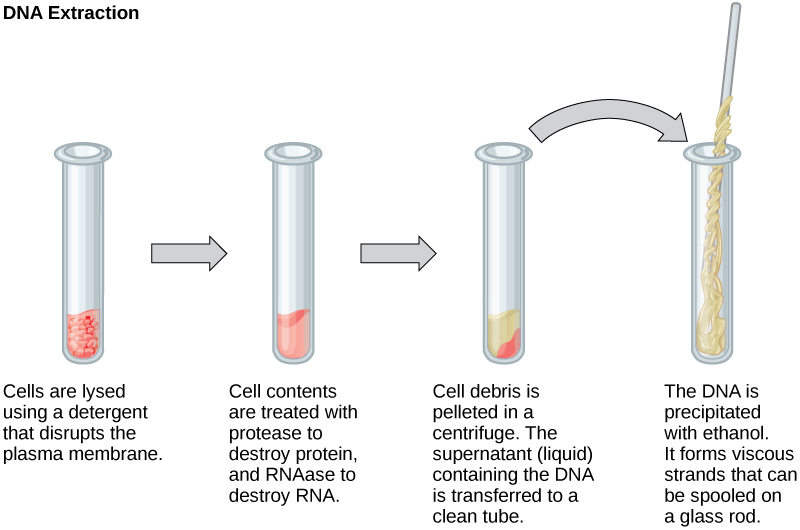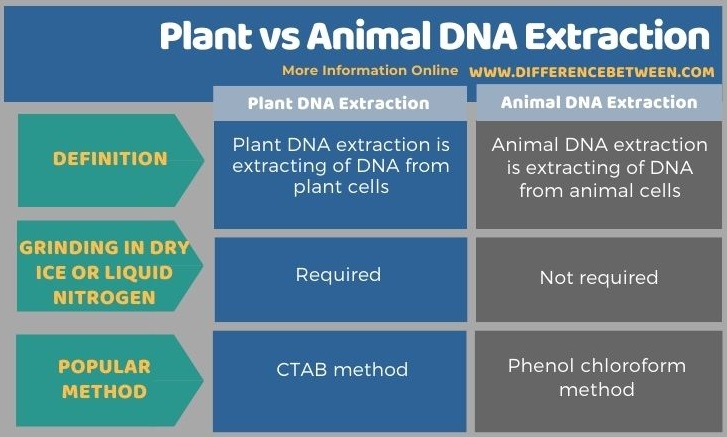The key difference between plant and animal DNA extraction is that in plant DNA extraction, it is necessary to break the cell wall by grinding the tissue in dry ice or liquid nitrogen in order to release cellular contents while in animal DNA extraction, it is not necessary to carry out this step since animal cells do not have a cell wall.
Genomic DNA is the genetic material of plant and animal cells. Genomic DNA is unique to each individual plant or animal. The DNA extraction of good-quality DNA is the prerequisite for molecular research. DNA of organisms is extracted for identification, diagnosis of diseases, detection of specific genes and sequences, forensic purposes, paternity testing, genome sequencing, and development of drugs, etc. DNA extraction method varies depending on the type of cells – whether it is an animal cell or a plant cell.
CONTENTS
1. Overview and Key Difference
2. What is Plant DNA Extraction
3. What is Animal DNA Extraction
4. Similarities Between Plant and Animal DNA Extraction
5. Side by Side Comparison – Plant vs Animal DNA Extraction in Tabular Form
6. Summary
What is Plant DNA Extraction?
DNA in plant cells are extracted for various molecular studies. It is required to extract intact, pure genomic DNA. Hence, there are different types of DNA extraction protocols which are different from the DNA extraction protocols from animal cells. This is because plant cells have a cell wall which should be broken in order to take out cellular contents.
Extraction is usually done by grinding the plant tissues in dry ice or liquid nitrogen using a mortar and pestle. Then the cell membranes are disrupted, and the cellular content is taken out into an extraction buffer. This is usually done using a detergent; SDS (sodium dodecyl sulfate) or CTAB (cetyltrimethylammonium bromide) buffer. The released DNA is protected from endogenous nucleases using a chelating agent such as EDTA. Moreover, proteins are separated from DNA using chloroform or phenol.

Figure 01: Plant DNA Extraction
Plants synthesize polysaccharides and polyphenols, including flavonoids and other secondary metabolites. These compounds interfere with the extraction of pure genomic DNA. Hence, most plant DNA extraction protocols involve another step, such as caesium chloride density gradient technique to eliminate these compounds.
Most of the DNA extraction protocols recommend using fresh leaf samples for DNA extraction. Some methods do not include hazardous chemicals such as liquid nitrogen and phenol. CTAB (Cetyl trimethylammonium bromide) protocol is a popular plant DNA extraction protocol which facilitates the extraction of high-quality plant genomic DNA. It is a simple, safe, reliable, and cost-efficient method for plant DNA extraction. Most of the other methods are modified versions of the CTAB method.
What is Animal DNA Extraction?
Animal DNA extraction is the extraction of genomic DNA from animal cells for molecular analysis. Unlike plant DNA extraction, breakdown of the cell wall is not necessary for animal cells since they lack a cell wall. Blood cells are the most common type of animal cells that are used for various purposes.

Figure 02: DNA Extraction
The phenol-chloroform method is one of the best choices for blood cells. The yield and quality of DNA are high when extracting DNA from this method. It is a liquid-liquid DNA extraction protocol, and this method separates DNA molecules on the basis of their solubility in immiscible solutions. Phenol, chloroform and isoamyl alcohol are the top three ingredients of this method.
What are the Similarities Between Plant and Animal DNA Extraction?
- During both plant and animal DNA extraction, cell membranes must be disrupted.
- The DNA should be protected from endogenous nucleases.
- Moreover, shearing of the DNA should be prevented.
- Commercial kits are available for the extraction of plant DNA and animal DNA.
- Most plant and animal DNA extraction methods need continuous modification and standardization.
What is the Difference Between Plant and Animal DNA Extraction?
The key difference between plant and animal DNA extraction is that plant DNA extraction requires the grinding of plant tissue in dry ice or liquid nitrogen in order to break the cell wall while animal DNA extraction does not require this step since they animal cells do not have a cell wall. CTAB method is one of the best methods for plant DNA extraction while the phenol-chloroform method is one of the best methods for animal DNA extraction.
Below infographic tabulates the differences between plant and animal DNA extraction.

Summary – Plant vs Animal DNA Extraction
Different methods are available for the extraction of DNA from different cell types. Therefore, plant DNA extraction protocols differ from animal cell DNA extraction protocols. Plant DNA extraction requires the disruption of the cell wall, cell membrane and nuclear membrane while animal DNA extraction requires the breakdown of the cell membrane and nuclear membrane. More importantly, animal cell DNA extraction does not require the disruption of cell walls by grinding in dry ice or liquid nitrogen. Thus, this is the key difference between plant and animal DNA extraction.
Reference:
1. “Phenol Chloroform DNA Extraction: Basics, Preparation of Chemicals and Protocol.” Genetic Education, 10 Jan. 2020, Available here.
2. Aljanabi, L. Forget, et al. “Extraction of High-Quality Genomic DNA from Different Plant Orders Applying a Modified CTAB-Based Method.” Bulletin of the National Research Centre, SpringerOpen, 1 Jan. 1999, Available here.
Image Courtesy:
1. “Science Laboratory. DNA extraction of a banana” By Manolacamboni – Own work (CC BY 4.0) via Commons Wikimedia
2. “Figure 17 01 02” By CNX OpenStax – (CC BY 4.0) via Commons Wikimedia
ncG1vNJzZmivp6x7pbXFn5yrnZ6YsqOx07CcnqZemLyue8OinZ%2Bdopq7pLGMm5ytr5Wau268y5qlrWWRo7Furc2ipJqkXZm7onnEsaurmZOptrC6jg%3D%3D